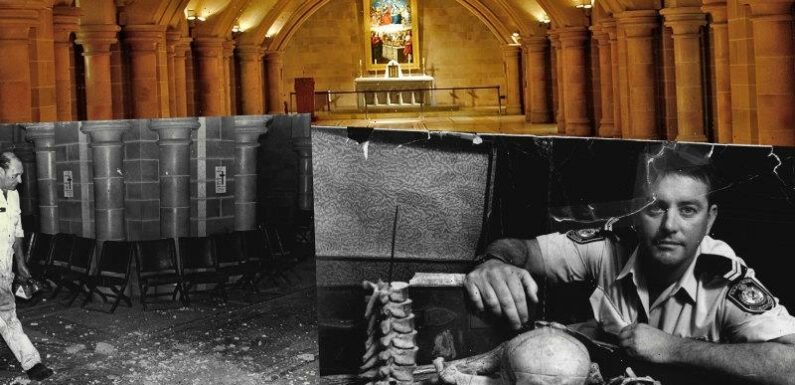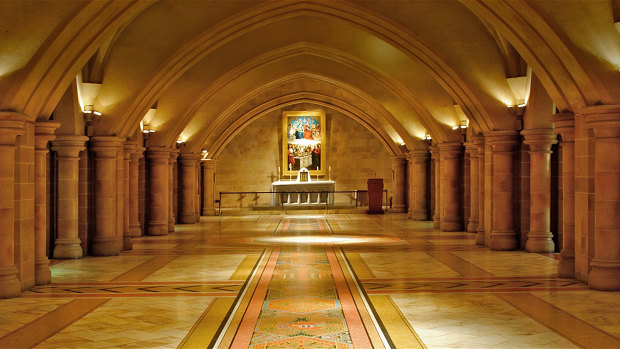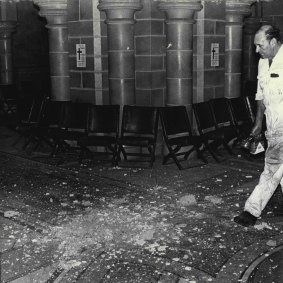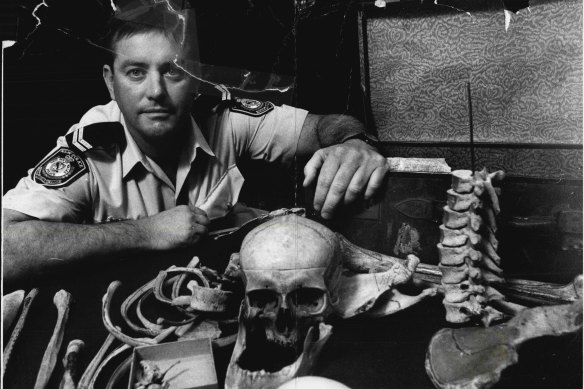
Upon his return to Australia, Cardinal George Pell’s body will be interred in the crypt underneath St Mary’s Cathedral, where a bomb exploded and was the final stop for the mysterious suitcase of bones.
The cathedral’s crypt – a 42-metre long and 21-metre wide underground room – is the final resting place for seven other deceased archbishops of the Sydney Catholic archdiocese and sits under the western edge of the cathedral near Hyde Park.
The crypt underneath St Mary’s Cathedral in Sydney.Credit:St Marys Cathedral
Despite spending the majority of his life in Victoria, including serving as the archbishop of Melbourne, the cardinal will be laid to rest in Sydney because it was his more recent appointment, said Dr Joel Hodge, a senior lecturer in theology at the Australian Catholic University.
“The key thing is that he’s being buried at the cathedral, where his chair was,” Hodge said, referring to the traditional chair of the archbishop that no other person can occupy.
“It’s a way of honouring his service but, more importantly, his symbolic value and his representational role of being a vicar of Christ for that place.”
Sergeant Bill Fahey on the crypt floor after a bomb exploded at St Mary’s Cathedral in 1973.Credit:Fairfax Media
The vast, cavernous crypt is adorned with a meticulously intricate tiled terrazzo and mosaic floor in the shape of a Celtic cross. Stained-glass windows line the walls and a rib vault ceiling arches high above the floor.
Built in 1928, the crypt was created by brothers Pietro, Antonio and Galliano Melocco, the first mosaic-producing tradesmen of NSW. They worked on the original flooring of the space, which includes the five medallions showing the days of Creation.
Hector Abrahams, a heritage architect who specialises in Christian and religious architecture, said the crypt is “particularly big and a little unusual” compared to others around the world.
“To have crypts with graves [of] important leaders is a very ancient tradition,” he said. But “it’s not located at the altar end, it’s in the west end”. (Crypts traditionally rest in the east of a cathedral.)
It was built almost as an afterthought: the cathedral is aligned from east to west and only after builders had established the eastern side of the cathedral, where the crypt usually lies, was a crypt made.
Senior Constable Peter Kelly with the collection of bones that were discovered in a suitcase at St Mary’s Cathedral in 1993.Credit:James Alcock
It is now the resting place of seven other former archbishops, who had served in Sydney: John Bede Polding, Roger Bede Vaughan, Patrick Francis Cardinal Moran, Michael Kelly, Norman Thomas Cardinal Gilroy, James Darcy Cardinal Freeman and Edward Bede Cardinal Clancy.
Aside from the extensive history of those interred there, the crypt is also home to two historic moments in Sydney’s history.
In 1973, a bomb exploded in the hall above, ripping through the ceiling of the crypt and damaging its floor. It was the fourth bomb reported in Sydney in the same number of days in a shocking series of attacks across the city.
And in 1993, “a suitcase full of human bones” was left on the crypt’s verandah. “Two skeletons, a pelvis, numerous teeth, finger bones and an incomplete spinal column” were wrapped in the pages of a 55-year-old newspaper, this masthead reported at the time.
Pell’s body will be interred after it arrives in Sydney following a service at the Vatican in the coming days.
The Morning Edition newsletter is our guide to the day’s most important and interesting stories, analysis and insights. Sign up here.
Most Viewed in National
From our partners
Source: Read Full Article


